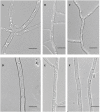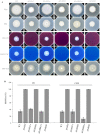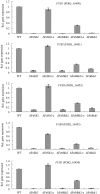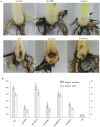Mitogen-activated protein kinases are associated with the regulation of physiological traits and virulence in Fusarium oxysporum f. sp. cubense
- PMID: 25849862
- PMCID: PMC4388850
- DOI: 10.1371/journal.pone.0122634
Mitogen-activated protein kinases are associated with the regulation of physiological traits and virulence in Fusarium oxysporum f. sp. cubense
Abstract
Fusarium oxysporum f. sp. cubense (FOC) is an important soil-borne fungal pathogen causing devastating vascular wilt disease of banana plants and has become a great concern threatening banana production worldwide. However, little information is known about the molecular mechanisms that govern the expression of virulence determinants of this important fungal pathogen. In this study, we showed that null mutation of three mitogen-activated protein (MAP) kinase genes, designated as FoSlt2, FoMkk2 and FoBck1, respectively, led to substantial attenuation in fungal virulence on banana plants. Transcriptional analysis revealed that the MAP kinase signaling pathway plays a key role in regulation of the genes encoding production of chitin, peroxidase, beauvericin and fusaric acid. Biochemical analysis further confirmed the essential role of MAP kinases in modulating the production of fusaric acid, which was a crucial phytotoxin in accelerating development of Fusarium wilt symptoms in banana plants. Additionally, we found that the MAP kinase FoSlt2 was required for siderophore biosynthesis under iron-depletion conditions. Moreover, disruption of the MAP kinase genes resulted in abnormal hypha and increased sensitivity to Congo Red, Calcofluor White and H2O2. Taken together, these results depict the critical roles of MAP kinases in regulation of FOC physiology and virulence.
Conflict of interest statement
Figures









Similar articles
-
A MADS-box transcription factor FoRlm1 regulates aerial hyphal growth, oxidative stress, cell wall biosynthesis and virulence in Fusarium oxysporum f. sp. cubense.Fungal Biol. 2020 Mar-Apr;124(3-4):183-193. doi: 10.1016/j.funbio.2020.02.001. Epub 2020 Feb 12. Fungal Biol. 2020. PMID: 32220379
-
Functional characterization of the gene FoOCH1 encoding a putative α-1,6-mannosyltransferase in Fusarium oxysporum f. sp. cubense.Fungal Genet Biol. 2014 Apr;65:1-13. doi: 10.1016/j.fgb.2014.01.005. Epub 2014 Feb 4. Fungal Genet Biol. 2014. PMID: 24503549
-
Fusaric acid instigates the invasion of banana by Fusarium oxysporum f. sp. cubense TR4.New Phytol. 2020 Jan;225(2):913-929. doi: 10.1111/nph.16193. Epub 2019 Oct 24. New Phytol. 2020. PMID: 31513293 Free PMC article.
-
Current status of the taxonomic position of Fusarium oxysporum formae specialis cubense within the Fusarium oxysporum complex.Infect Genet Evol. 2011 Apr;11(3):533-42. doi: 10.1016/j.meegid.2011.01.012. Epub 2011 Jan 21. Infect Genet Evol. 2011. PMID: 21256980 Review.
-
Host-Pathogen Interaction in Fusarium oxysporum Infections: Where Do We Stand?Mol Plant Microbe Interact. 2018 Sep;31(9):889-898. doi: 10.1094/MPMI-12-17-0302-CR. Epub 2018 Jul 27. Mol Plant Microbe Interact. 2018. PMID: 29547356 Review.
Cited by
-
Patho-Ecological Distribution and Genetic Diversity of Fusarium oxysporum f. sp. cubense in Malbhog Banana Belts of Assam, India.J Fungi (Basel). 2025 Mar 4;11(3):195. doi: 10.3390/jof11030195. J Fungi (Basel). 2025. PMID: 40137233 Free PMC article.
-
Fusarium oxysporum f. sp. lycopersici C2H2 transcription factor FolCzf1 is required for conidiation, fusaric acid production, and early host infection.Curr Genet. 2019 Jun;65(3):773-783. doi: 10.1007/s00294-019-00931-9. Epub 2019 Jan 10. Curr Genet. 2019. PMID: 30631890
-
Phospho-code of a conserved transcriptional factor underpins fungal virulence.BMC Biol. 2024 Aug 26;22(1):179. doi: 10.1186/s12915-024-01978-y. BMC Biol. 2024. PMID: 39183278 Free PMC article.
-
The MAPKKK CgMck1 Is Required for Cell Wall Integrity, Appressorium Development, and Pathogenicity in Colletotrichum gloeosporioides.Genes (Basel). 2018 Nov 8;9(11):543. doi: 10.3390/genes9110543. Genes (Basel). 2018. PMID: 30413120 Free PMC article.
-
Predicting Virulence of Fusarium Oxysporum f. sp. Cubense Based on the Production of Mycotoxin Using a Linear Regression Model.Toxins (Basel). 2020 Apr 14;12(4):254. doi: 10.3390/toxins12040254. Toxins (Basel). 2020. PMID: 32295210 Free PMC article.
References
-
- Qi XZ, Guo LJ, Yang LY, Huang JS (2013) Foatf1, a bZIP transcription factor of Fusarium oxysporum f. sp cubense, is involved in pathogenesis by regulating the oxidative stress responses of Cavendish banana (Musa spp.). Physiol Mol Plant P 84: 76–85.
Publication types
MeSH terms
Substances
LinkOut - more resources
Full Text Sources
Other Literature Sources

